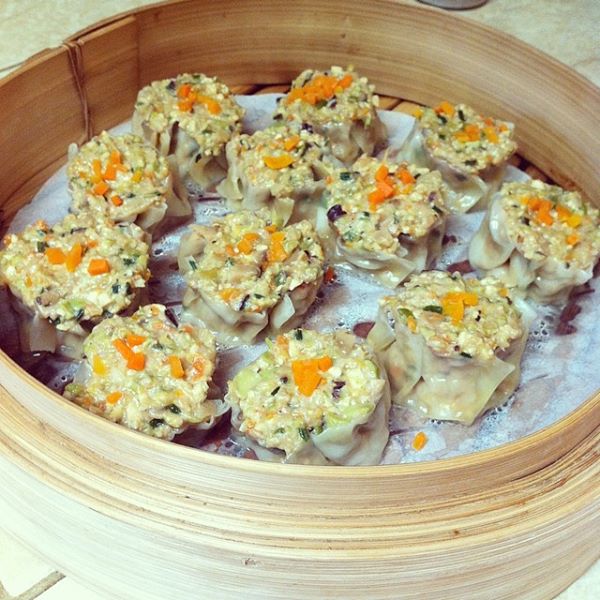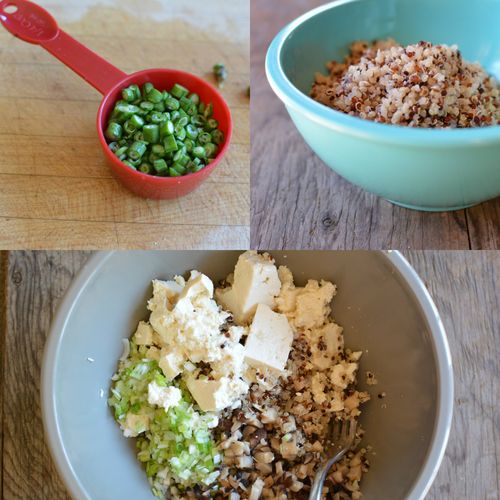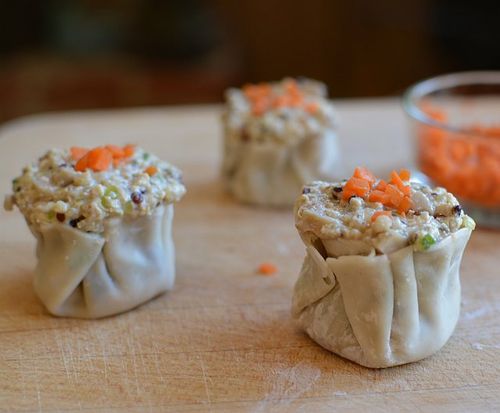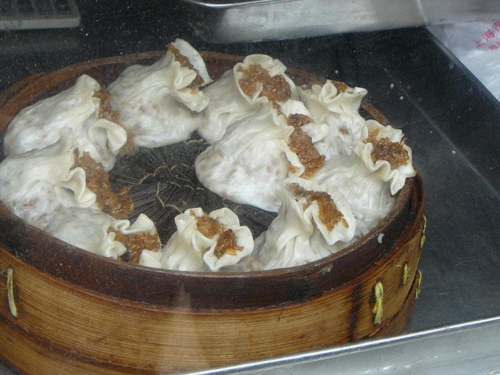First off, thanks for the responses to Bo Gia's ginseng seed giveaway! I know that he is totally tickled and for the first time, is participating in VWK's conversation in the post's comments.
Earlier this year, I posted a photo of a vegetarian shu mai dumpling that I whipped up using filling leftover from a consulting gig. Someone on Instagram asked if I’d used quinoa, the ancient seed that’s super popular now. No I had not but what a great idea. Quinoa has protein and a good chewy texture to mimic meat. I’ve eaten quinoa since the mid-1990s and enjoyed it in side dishes and stuffing for roast squash. What would it be like as a dumpling filling?
I made a double batch of quinoa one night and saved the leftover for experimenting. When I cook quinoa, I toast it in first in a pan over moderate heat until it’s toasty/roasty smelling. This gives the quinoa a little extra character.
Then I briefly cool the grains, then rinse them in a fine mesh strainer and add water. Usually it’s a 1:2 ratio of quinoa to water with about ¼ teaspoon of salt for every 2 cups of water. The actual cooking resembles cooking a pot of rice, but I just bring it to a boil, stir things around for 1 minute, lower the heat and cook for 10 minutes on low. Rest then fluff, then rest again before eating.
I had a blend of quinoa that night, purchased from the bulk bin at the health food store. The reddish brown seeds imparted more personality to the filling. (Quinoa is technically a seed, though many people think of it as a grain.)
Quinoa alone would be kind of one or two-dimensional so I added tofu for a softer texture and protein. The remaining ingredients were for seasoning and binding the filling. The cool thing with this vegetarian filling is you can taste it -- if raw egg white is okay with you -- before using it.
As you see from the top photo, the resulting shu mai dumplings were a little wobbly but perfectly edible! These reminded me of a Shanghai-style shu mai (shao mai in Mandarin) dumpling filled with sticky rice. Yes, it's carb upon carb. Here’s a photo from my Asian dumpling research trip in 2007:
Dumplings don’t have to look perfect to taste great. Seriously. Give this a try if you’re a vegetarian. If you’re vegan or allergic to eggs, omit the egg white and increase the cornstarch by 50 percent and see what happens. The egg white is there for a firmish texture and delicate texture.
How'd the quinoa and tofu shu mai taste? Pretty darn good. They are lighter and more delicate than the classic pork or pork and shrimp shu mai. Perfectly good in their own right.
Recipe
Quinoa and Tofu Shu Mai
Yields: 24 to 30 dumplings, serving 6 to 8 as a snack
Filling
- 8 ounces (425 g) firm or extra firm tofu
- 1 packed cup ( 6 oz / 180 g) cooked quinoa
- 4 large dried shiitake mushrooms, reconstituted, stemmed, and chopped (½ cup)
- 3 tablespoons chopped green beans
- 1 green onion, chopped
- ¼ teaspoon salt
- Generous 1 teaspoon sugar
- ¼ teaspoon white pepper
- 1 tablespoon cornstarch
- 1 tablespoon regular soy sauce
- 1 ½ teaspoons sesame oil
- 1 large egg white, beaten
- 30 small (3 in / 7.5 cm) round siu mai skins or 24 medium (3.25 cm / 8 cm) gyoza/potsticker wrappers
- 1 ½ tablespoons finely diced carrot, for garnish
- Regular soy sauce
- Chinese hot mustard or Colman’s English mustard
Method:
1. Standing over the sink, gently squeeze the tofu to break it up and release some of the water; you don’t have to make it totally dry. Put the tofu into a bowl. Add the quinoa, mushroom room, onion, and green onion. Stir and lightly mash the ingredients together so they begin to blend.
2. Put the salt, sugar, white pepper, cornstarch, soy sauce, sesame oil, and egg white into a small bowl and stir combine well. Pour over the tofu and quinoa mixture, and stir, fold, and mash everything together until they cohere into a compact mass. Taste and adjust the seasonings, if needed. Cover with plastic wrap and set aside for 30 minutes. You should have a generous 2 cups of filling.
3. Line steamer trays with parchment paper; if you expect overflow, line a baking sheet with parchment and dust with cornstarch. Set aside.
4. Hold a skin in one hand. Scoop up about 1 tablespoon of filling with a bamboo dumpling spatula, dinner knife, or fork and position it in the center of the skin, pressing down gently. Pick up the skin and gather and pinch it together to form an open bag. Set in on your work surface to ensure it sits up well. Crown the dumpling with some finely diced carrot or a pea.
Place in a steamer tray open side up, spacing them ½ inch apart and 1 inch away from the edge. If you are unable to steam all the dumplings at once, place the waiting ones on the baking sheet a good ½ inch apart. Keeping the finished dumplings covered with a dry kitchen towel to prevent drying, make more dumplings from the filling and wrappers.
5. To cook, steam the dumplings over boiling water for 6 to 8 minutes, until the dumplings have puffed slightly and their skins have become translucent. Remove each tray and place it atop a serving plate. Serve immediately with the soy sauce and hot mustard. Invite guests to mix up their own dipping sauce from soy sauce and mustard.




















